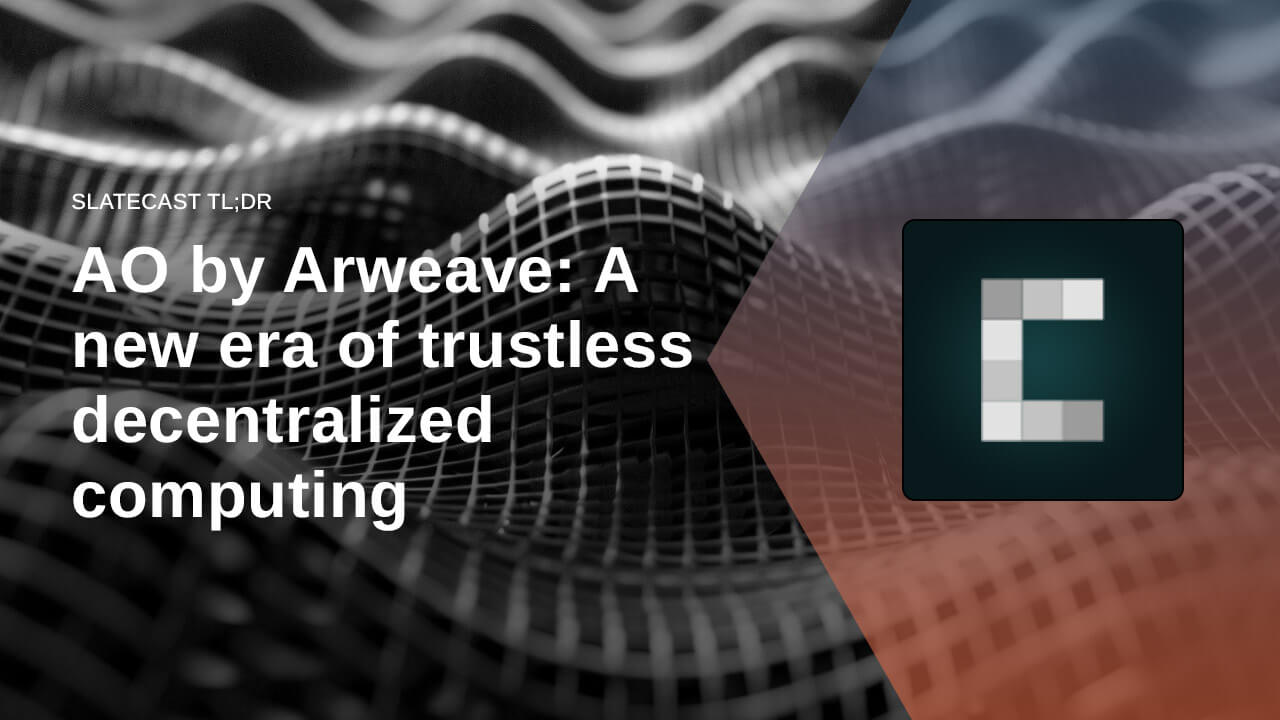
In a highly anticipated SlateCast episode, Sam Williams, the visionary founder of Arweave, joined Liam “Akiba” Wright and Nate Whitehill to unveil AO, Arweave’s groundbreaking decentralized supercomputer protocol.
Promising to disrupt decentralized computing, AO introduces novel approaches to parallel processing and message passing, aiming to create a trustless, scalable, and intelligent market for computation.
The Genesis of AO
Recounting the origins of AO, Williams shared his vision of creating a decentralized ledger of knowledge and speech that could withstand the test of time. As Arweave gained traction, he realized the potential for a decentralized computing system built upon the permanent log of information.
“We essentially set out to solve that problem. How do we make a ledger of history and speech, that is replicated around the world with no single centralized point of failure so that we can do for speech what Bitcoin did for money, basically, make it trustless, your access to speech in cyberspace,” Williams explained.
A Fair and Incentivized Launch
Williams highlighted the importance of AO’s fair launch, with no pre-mining or pre-sales, a departure from many blockchain projects:
“We ended up going with a system that actually splits its token components between, giving value to Arweave token holders, which incentivizes the security of its base layer, which is good for AO, good for Arweave, and also for bridging assets from other networks.”
Scalability and Parallel Processing
AO promises to handle high transaction volumes and massive datasets through its modular architecture. Williams elaborated on the system’s scalability, explaining,
“You have these different subnets that are responsible for different parts of the system.
All of them are staked using the AO token, and you basically stake against the correctness of a state transition of one form or another.”
Decentralized Finance and Agent Intelligence
One of AO’s most exciting potential applications lies in decentralized finance and agent intelligence.
Williams painted a picture of trustless, immutable hedge funds and autonomous trading strategies executing on the decentralized supercomputer.
“With AO, you can bring all of that inside the system too, and make it trustless. So, simple example to make it sort of concrete, imagine a decentralized hedge fund with an immutable strategy. Anyone can make it, just like anyone can put together a smart contract on Ethereum. And you don’t have to trust that person in order to use it,” Williams said.
The Future of AO and Arweave
Looking ahead, Williams shared his vision for AO and Arweave, aiming to create a globally distributed, decentralized, and trustless supercomputer accessible to everyone at minimal viable cost.
Arweave’s journey continues as a neutral, permanent archive of knowledge and speech, paving the way for a composable data ecosystem where users retain ownership and rights over their content.
“Long term, that’s really where we wanted to go. But short term, we’re really interested in things like agent finance,” Williams stated, emphasizing the potential impact of AO on the broader blockchain and tech landscape.
As AO’s bridges go live, developers and users are invited to explore this novel decentralized computing paradigm. With its fair launch, incentivized tokenomics, and ambitious goals, AO has the potential to reshape the landscape of decentralized computing and pave the way for a genuinely trustless, scalable, and intelligent market for computation.
NEW PODCAST 🎙️ Decoding AO: Sam Williams Unveils Arweave’s Decentralized Supercomputer
Guest: @samecwilliams of @ArweaveEco & @aoTheComputer
Co-Hosts: @akibablade and @NateWhitehill pic.twitter.com/9YLDMxXYl0— CryptoSlate (@CryptoSlate) June 13, 2024
 Bitcoin
Bitcoin  Ethereum
Ethereum  Tether
Tether  XRP
XRP  USDC
USDC  Solana
Solana  TRON
TRON  Lido Staked Ether
Lido Staked Ether  Dogecoin
Dogecoin  Figure Heloc
Figure Heloc  Cardano
Cardano  WhiteBIT Coin
WhiteBIT Coin  Bitcoin Cash
Bitcoin Cash  Wrapped stETH
Wrapped stETH  Wrapped Bitcoin
Wrapped Bitcoin  USDS
USDS  Wrapped eETH
Wrapped eETH  Binance Bridged USDT (BNB Smart Chain)
Binance Bridged USDT (BNB Smart Chain)  Chainlink
Chainlink  Monero
Monero  LEO Token
LEO Token  WETH
WETH  Zcash
Zcash  Stellar
Stellar  Hyperliquid
Hyperliquid  Coinbase Wrapped BTC
Coinbase Wrapped BTC  Ethena USDe
Ethena USDe  Litecoin
Litecoin  Sui
Sui  Avalanche
Avalanche  Hedera
Hedera  sUSDS
sUSDS  Shiba Inu
Shiba Inu  USDT0
USDT0  Dai
Dai  Canton
Canton  Uniswap
Uniswap  PayPal USD
PayPal USD  Mantle
Mantle  Cronos
Cronos  World Liberty Financial
World Liberty Financial  Toncoin
Toncoin  Ethena Staked USDe
Ethena Staked USDe  Polkadot
Polkadot  USD1
USD1  Aave
Aave  Rain
Rain  Bitget Token
Bitget Token 


